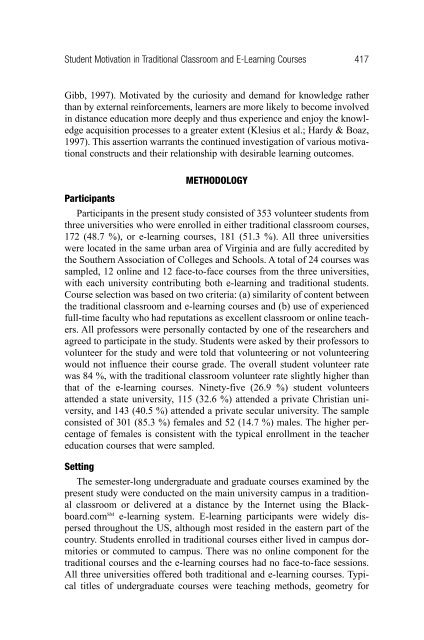A Comparative Analysis of Student Motivation in ... - Anitacrawley.net
A Comparative Analysis of Student Motivation in ... - Anitacrawley.net
A Comparative Analysis of Student Motivation in ... - Anitacrawley.net
You also want an ePaper? Increase the reach of your titles
YUMPU automatically turns print PDFs into web optimized ePapers that Google loves.
<strong>Student</strong> <strong>Motivation</strong> <strong>in</strong> Traditional Classroom and E-Learn<strong>in</strong>g Courses 417Gibb, 1997). Motivated by the curiosity and demand for knowledge ratherthan by external re<strong>in</strong>forcements, learners are more likely to become <strong>in</strong>volved<strong>in</strong> distance education more deeply and thus experience and enjoy the knowledgeacquisition processes to a greater extent (Klesius et al.; Hardy & Boaz,1997). This assertion warrants the cont<strong>in</strong>ued <strong>in</strong>vestigation <strong>of</strong> various motivationalconstructs and their relationship with desirable learn<strong>in</strong>g outcomes.METHODOLOGYParticipantsParticipants <strong>in</strong> the present study consisted <strong>of</strong> 353 volunteer students fromthree universities who were enrolled <strong>in</strong> either traditional classroom courses,172 (48.7 %), or e-learn<strong>in</strong>g courses, 181 (51.3 %). All three universitieswere located <strong>in</strong> the same urban area <strong>of</strong> Virg<strong>in</strong>ia and are fully accredited bythe Southern Association <strong>of</strong> Colleges and Schools. A total <strong>of</strong> 24 courses wassampled, 12 onl<strong>in</strong>e and 12 face-to-face courses from the three universities,with each university contribut<strong>in</strong>g both e-learn<strong>in</strong>g and traditional students.Course selection was based on two criteria: (a) similarity <strong>of</strong> content betweenthe traditional classroom and e-learn<strong>in</strong>g courses and (b) use <strong>of</strong> experiencedfull-time faculty who had reputations as excellent classroom or onl<strong>in</strong>e teachers.All pr<strong>of</strong>essors were personally contacted by one <strong>of</strong> the researchers andagreed to participate <strong>in</strong> the study. <strong>Student</strong>s were asked by their pr<strong>of</strong>essors tovolunteer for the study and were told that volunteer<strong>in</strong>g or not volunteer<strong>in</strong>gwould not <strong>in</strong>fluence their course grade. The overall student volunteer ratewas 84 %, with the traditional classroom volunteer rate slightly higher thanthat <strong>of</strong> the e-learn<strong>in</strong>g courses. N<strong>in</strong>ety-five (26.9 %) student volunteersattended a state university, 115 (32.6 %) attended a private Christian university,and 143 (40.5 %) attended a private secular university. The sampleconsisted <strong>of</strong> 301 (85.3 %) females and 52 (14.7 %) males. The higher percentage<strong>of</strong> females is consistent with the typical enrollment <strong>in</strong> the teachereducation courses that were sampled.Sett<strong>in</strong>gThe semester-long undergraduate and graduate courses exam<strong>in</strong>ed by thepresent study were conducted on the ma<strong>in</strong> university campus <strong>in</strong> a traditionalclassroom or delivered at a distance by the Inter<strong>net</strong> us<strong>in</strong>g the Blackboard.comSM e-learn<strong>in</strong>g system. E-learn<strong>in</strong>g participants were widely dispersedthroughout the US, although most resided <strong>in</strong> the eastern part <strong>of</strong> thecountry. <strong>Student</strong>s enrolled <strong>in</strong> traditional courses either lived <strong>in</strong> campus dormitoriesor commuted to campus. There was no onl<strong>in</strong>e component for thetraditional courses and the e-learn<strong>in</strong>g courses had no face-to-face sessions.All three universities <strong>of</strong>fered both traditional and e-learn<strong>in</strong>g courses. Typicaltitles <strong>of</strong> undergraduate courses were teach<strong>in</strong>g methods, geometry for
















